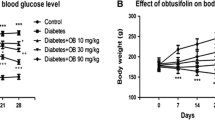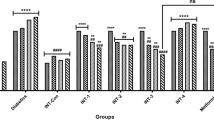Abstract
Interest in phytochemical therapy methods in the treatment of diabetes is increasing day by day. Although the antidiabetic and antioxidant effects of Cistus laurifolius L. (CL) have been mentioned, the systemic effects remain unknown. The present study aims at evaluating the antidiabetic effects of the CL aqueous extract via metformin on streptozotocin (STZ)-induced diabetic rats. Forty male Wistar albino rats were divided into five groups of eight animals each: control, diabetic group (55mg/kg STZ), STZ+125mg/kg CL, STZ+250mg/kg CL, and STZ+100mg/kg metformin. The effects of CL and metformin on oxidative, apoptotic, and inflammatory pathways were comparatively investigated. In addition, nuclear factor-κB (NFκB), tumor necrosis factor-alpha (TNF-α), and interleukin (IL)-1β expressions analysis were carried out. CL treatment resulted in a significant improvement in blood glucose levels, lipid profile, pancreatic markers, and liver and kidney function tests. A 250mg/kg CL treatment decreased by 67.9%, 31.6%, 66.8%, 28.3%, and 31.4% in the total oxidant capacity, NFκB, TNF-α, IL-1β, caspase3, and cytochrome c levels, respectively, compared to the diabetic group. Additionally, CL treatments showed a dose-dependent reduction in NFκB, TNF-α, and IL-1β expression levels. A 250mg/kg CL treatment exhibited a greater increase (by 9.6%) in total antioxidant capacity than metformin. CL treatment provided histologically more improvement in the brain, heart, pancreas, spleen, liver, kidney, and testicular tissues compared to the metformin group. Our results suggest that the single treatment of CL aqueous extract at the low doses may have stronger short-term anti-diabetic effects than metformin. Therefore, further studies are needed regarding the long-term hypoglycemic effect or treatment of CL aqueous extract.



Similar content being viewed by others
References
Akkol EK, Orhan IE, Yesilada E (2012) Anticholinesterase and antioxidant effects of the ethanol extract, ethanol fractions and isolated flavonoids from Cistus laurifolius L. leaves. Food Chem 131(2):626–631. https://doi.org/10.1016/j.foodchem.2011.09.041
Akyuz E, Sahin H, Islamoglu F, Kolayli S, Sandra P (2014) Evaluation of phenolic compounds in Tilia rubra subsp. caucasica by HPLC-UV and HPLC-UV-MS/MS. Int J Food Prop 17:331–343. https://doi.org/10.1080/10942912.2011.631252
Asmat U, Abad K, Ismail K (2016) Diabetes mellitus and oxidative stress—a concise review. Saudi Pharm J 24(5):547–553. https://doi.org/10.1016/j.jsps.2015.03.013
Datusalia AK, Sharma SS (2016) NF-κB inhibition resolves cognitive deficits in experimental type 2 diabetes mellitus through CREB and glutamate/GABA neurotransmitters pathway. Curr Neurovasc Res 13(1):22–32. https://doi.org/10.2174/1567202612666151030104810
Diaz-Morales N, Rovira-Llopis S, Bañuls C, Lopez-Domenech S, Escribano-Lopez I, Veses S, Jover A, Rocha M, Hernandez-Mijares A, Victor VM (2017) Does metformin protect diabetic patients from oxidative stress and leukocyte-endothelium interactions? Antioxid Redox Signal 27(17):1439–1445. https://doi.org/10.1089/ars.2017.7122
Diniz Vilela D, Gomes Peixoto L, Teixeira RR, Belele Baptista N, Carvalho Caixeta D, Vieira de Souza A, Machado HL, Pereira MN, Sabino-Silva R, Espindola FS (2016) The role of metformin in controlling oxidative stress in muscle of diabetic rats. Oxidative Med Cell Longev 9:6978625. https://doi.org/10.1155/2016/6978625
Gu J, Ye S, Wang S, Sun W, Hu Y (2014) Metformin inhibits nuclear factor-κB activation and inflammatory cytokines expression induced by high glucose via adenosine monophosphate-activated protein kinase activation in rat glomerular mesangial cells in vitro. Chin Med J 127(9):1755–1760
He X, Yao MW, Zhu M, Liang DL, Guo W, Yang Y, Zhao RS, Ren TT, Ao X, Wang W, Zeng CY, Liang HP, Jiang DP, Yu J, Xu X (2018) Metformin induces apoptosis in mesenchymal stromal cells and dampens their therapeutic efficacy in infarcted myocardium. Stem Cell Res Ther 9(1):306. https://doi.org/10.1186/s13287-018-1057-0
International Diabetes Federation (IDF). IDF Diabetes Atlas. 8th ed. Brussels. 2017.
Kothari V, Galdo JA, Mathews ST (2016) Hypoglycemic agents and potential antiinflammatory activity. J Inflamm Res 9:27–38. https://doi.org/10.2147/JIR.S86917
Kumazawa S, Hamasaka T, Nakayama T (2004) Antioxidant activity of propolis of various geographic origins. Food Chem 84(3):329–339. https://doi.org/10.1016/S0308-8146(03)00216-4
Kupeli E, Yesilada E (2007) Flavonoids with anti-inflammatory and antinociceptive activity from Cistus laurifolius L. leaves through bioassay-guided procedures. J Ethnopharmacol 112(3):524–530. https://doi.org/10.1016/j.jep.2007.04.011
Kurup SB, Mini SS (2017) Protective potential of Averrhoa bilimbi fruits in ameliorating the hepatic key enzymes in streptozotocin-induced diabetic rats. Biomed Pharmacother 85:725–732. https://doi.org/10.1016/j.biopha.2016.11.088
Lee Y, Berglund ED, Wang MY, Fu X, Yu X, Charron MJ, Burgess SC, Unger RH (2012) Metabolic manifestations of insulin deficiency do not occur without glucagon action. Proc Natl Acad Sci U S A 109(37):14972–14976. https://doi.org/10.1073/pnas.1205983109
Leslie RD, Palmer J, Schloot NC, Lernmark A (2016) Diabetes at the crossroads: relevance of disease classification to pathophysiology and treatment. Diabetologia 59(1):13–20. https://doi.org/10.1007/s00125-015-3789-z
Liu T, Zhang L, Joo D, Sun SC (2017) NF-κB signaling in inflammation. Signal Transduct Target Ther 2:17023. https://doi.org/10.1038/sigtrans.2017.23
Livingstone R, Boyle JG, Petrie JR, REMOVAL Study Team (2017) A new perspective on metformin therapy in type 1 diabetes. Diabetologia 60(9):1594–1600. https://doi.org/10.1007/s00125-017-4364-6
Loizzo MR, Jemia MB, Senatore F, Bruno M, Menichini F, Tundis R (2013) Chimistry and functional properties in prevention of neurodegenerative disorders of five Cistus species essential oils. Food Chem Toxicol 59:586–594. https://doi.org/10.1016/j.fct.2013.06.040
Muriach M, Flores-Bellver M, Romero FJ, Barcia JM (2014) Diabetes and the brain: oxidative stress, inflammation, and autophagy. Oxidative Med Cell Longev 102158(2014):1–9. https://doi.org/10.1155/2014/102158
Orhan N, Aslan M, Sukuroglu M, Deliorman Orhan D (2013) In vivo and in vitro antidiabetic effect of Cistus laurifolius L. and detection of major phenolic compounds by UPLC-TOF-MS analysis. J Ethnopharmacol 146(3):859–865. https://doi.org/10.1016/j.jep.2013.02.016
Ortis F, Naamane N, Flamez D, Ladrière L, Moore F, Cunha DA, Colli ML, Thykjaer T, Thorsen K, Orntoft TF, Eizirik DL (2010) Cytokines interleukin-1beta and tumor necrosis factor-alpha regulate different transcriptional and alternative splicing networks in primary beta-cells. Diabetes 59(2):358–374. https://doi.org/10.2337/db09-1159
Polat R, Satıl F (2012) An ethnobotanical survey of medicinal plants in Edremit Gulf (Balıkesir-Turkey). J Ethnopharmacol 139(2):626–641. https://doi.org/10.1016/j.jep.2011.12.004
Pyrzynska K, Pekala A (2013) Application of free radical diphenylpicrylhydrazyl (DPPH) to estimate the antioxidant capacity of food samples. Anal Methods 5:4288–4295. https://doi.org/10.1039/C3AY40367J
Ramos RTM, Bezerra ICF, Ferreira MRA, Soares LAL (2017) Spectrophotometric quantification of flavonoids in herbal material, crude extract, and fractions from leaves of Eugenia uniflora Linn. Pharm Res 9(3):253–260. https://doi.org/10.4103/pr.pr_143_16
Rehman K, Akash MSH (2017) Mechanism of generation of oxidative stress and pathophysiology of type 2 diabetes mellitus: how are they interlinked? J Cell Biochem 118(11):3577–3585. https://doi.org/10.1002/jcb.26097
Sadhu SK, Okuyama E, Fujimoto H, Ishibashi M, Yesilada E (2006) Prostaglandin inhibitory and antioxidant components of Cistus laurifolius, a Turkish medicinal plant. J Ethnopharmacol 108:371–378. https://doi.org/10.1016/j.jep.2006.05.024
Saisho Y (2015) Metformin and Inflammation: its potential beyond glucose-lowering effect. Endocr Metab Immune Disord Drug Targets 15(3):196–205. https://doi.org/10.2174/1871530315666150316124019
Sayah KL, Chemlal L, Marmouzi I, El Jemli M, Cherrah Y, Faouzi MEA (2017) In vivo anti-inflammatory and analgesic activities of Cistus salviifolius (L.) and Cistus monspeliensis (L.) aqueous extracts. S Afr J Bot 113:160–163. https://doi.org/10.1016/j.sajb.2017.08.015
Sayah K, Mrabti HN, Belarj B, Kichou F, Cherrah Y, El Abbes Faouzi M (2020) Evaluation of antidiabetic effect of Cistus salviifolius L. (Cistaceae) in streptozotocin-nicotinamide induced diabetic mice [published online ahead of print, 2020 Oct 5]. J Basic Clin Physiol Pharmacol 32:121–127. https://doi.org/10.1515/jbcpp-2020-0044
Sena P, Mancini S, Benincasa M, Mariani F, Palumbo C, Roncucci L (2018) Metformin induces apoptosis and alters cellular responses to oxidative stress in Ht29 colon cancer cells: preliminary findings. Int J Mol Sci 19(5):1–16. https://doi.org/10.3390/ijms19051478
Soares JMD, Pereira Leal AEB, Silva JC, Almeida JRGS, de Oliveira HP (2017) Influence of flavonoids on mechanism of modulation of insulin secretion. Pharmacogn Mag 13(52):639–646. https://doi.org/10.4103/pm.pm_87_17
Soskić SS, Dobutović BD, Sudar EM, Obradović MM, Nikolić DM, Djordjevic JD, Radak DJ, Mikhailidis DP, Isenović ER (2011) Regulation of inducible nitric oxide synthase (iNOS) and its potential role in insulin resistance, diabetes and heart failure. The Open Cardiovascular Medi J 5:153–163. https://doi.org/10.2174/1874192401105010153
Tsalamandris S, Antonopoulos AS, Oikonomou E, Papamikroulis GA, Vogiatzi G, Papaioannou S, Deftereos S, Tousoulis D (2019) The role of inflammation in diabetes: current concepts and future perspectives. Eur Cardiol 14(1):50–59. https://doi.org/10.15420/ecr.2018.33.1
Van Opdenbosch N, Lamkanfi M (2019) Caspases in cell death, inflammation, and disease. Immunity 50(6):1352–1364. https://doi.org/10.1016/j.immuni.2019.05.020
Wang Y, An H, Liu T, Qin C, Sesaki H, Guo S, Radovick S, Hussain M, Maheshwari A, Wondisford FE, O'Rourke B, He L (2019) Metformin improves mitochondrial respiratory activity through activation of AMPK. Cell Rep 29(6):1511–1523.e5. https://doi.org/10.1016/j.celrep.2019.09.070
Wang-Fischer Y, Garyantes T (2018) Improving the reliability and utility of streptozotocin-induced rat diabetic model. J Diabetes Res 2018:8054073–8054014. https://doi.org/10.1155/2018/8054073
Yesilada E, Gurbuz I, Ergun E (1997) Effects of Cistus laurifolius L. flowers on gastric and duodenal lesions. J Ethnopharmacol 55:201–211. https://doi.org/10.1016/S0378-8741(96)01502-4
Zhong J, Gong Q, Mima A (2017) Inflammatory regulation in diabetes and metabolic dysfunction. J Diabetes Res 2017:5165268–5165262. https://doi.org/10.1155/2017/5165268
Availability of data and materials
Not applicable.
Ethical approval
The experimental procedure on animals was confirmed by the Eskisehir Osmangazi University Animal Experiments Local Ethics Committee (Approval number: 678-1).
Consent to participate
Not applicable.
Consent to publish
Not applicable.
Author information
Authors and Affiliations
Contributions
CH, FK, and GK made experimental design and participated in data collection. CH, FK, and HS formed the experimental diabetes model in rats. CH, FK, and GK analyzed and interpreted biochemical measurements. EY provided the plant material and prepared its extract. YK analyzed the total flavonoid and phenolic compounds in the plant extract. DBD performed the histological examination of the brain, heart, pancreas, spleen, liver, kidney, and testis. CH was a major contributor in writing the manuscript. All authors read and approved the final manuscript.
Corresponding author
Ethics declarations
The authors declare no competing interests.
Additional information
Responsible Editor: Mohamed M. Abdel-Daim
Publisher’s note
Springer Nature remains neutral with regard to jurisdictional claims in published maps and institutional affiliations.
Rights and permissions
About this article
Cite this article
Hacioglu, C., Kar, F., Kara, Y. et al. Comparative effects of metformin and Cistus laurifolius L. extract in streptozotocin-induced diabetic rat model: oxidative, inflammatory, apoptotic, and histopathological analyzes. Environ Sci Pollut Res 28, 57888–57901 (2021). https://doi.org/10.1007/s11356-021-14780-y
Received:
Accepted:
Published:
Issue Date:
DOI: https://doi.org/10.1007/s11356-021-14780-y




